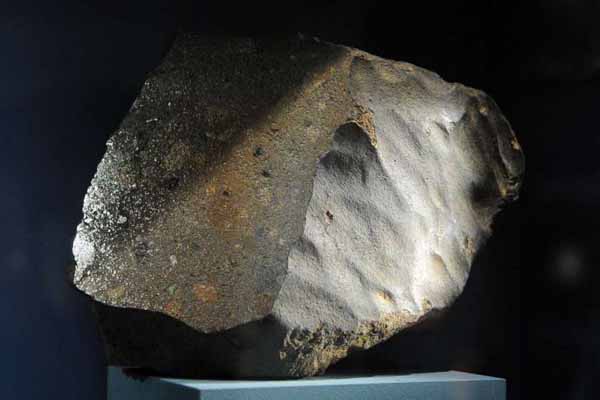Weston Meteorite

Weston Meteorite - December 14, 1807
At 6:30 on the morning of December 14, 1807, a blazing fireball about two-thirds the size of the moon was seen traveling southwards by early risers in Vermont and Massachusetts. Three loud explosions were heard over the town of Weston in Fairfield County, Connecticut. Stone fragments fell in at least 6 places.
Two or three days later Benjamin Silliman heard of it, dropped everything he was doing and, with Professor James L. Kingsley, immediately went to Weston to investigate. They visited every locality where stones had been reported to fall and interviewed many eyewitnesses. Several large stones, including one of about 200 pounds (91 kilograms), had been smashed to bits on the rocky ground. Others were smashed by the finders: "Strongly impressed with the idea that these stones contained gold and silver, they subjected them to all the tortures of ancient alchemy, and the goldsmith's crucible, the forge, and the blacksmith's anvil, were employed in vain to elicit riches which existed only in the imagination." With difficulty Silliman and Kingsley managed to procure fragments of each stone that had fallen, and came away with "a considerable number of specimens."
On December 29 they published a detailed description in the Connecticut Herald of the fireball, the explosions (heard more than 40 miles [64 kilometers] away), and the fall of the stones. The description was quickly reprinted in other publications. A revised version—with a chemical analysis of the meteorite made by Silliman, the first to be performed in this country and among the first few in the world—was read before the American Philosophical Society in March 1808, and published in its Transactions the following year. "The case was deemed so interesting and important that the published account was read aloud in the Philosophical Society of London & in the Academy of Sciences of Paris. It was admitted to be one of the most extensive and best attested occurrences of the kind that has happened and of which a record has been preserved."
Silliman's luck in this instance was extraordinary. Fireballs had been seen in New England and other settled parts of this country in the 17th and 18th centuries, but it is likely that the fall of a single stone, or even of a few, would have gone unnoticed or reports of them disbelieved. In fact, it was only around 1800 that a few mineralogists and chemists in Europe had begun to realize that the stones and chunks of iron reported to fall from the heavens were distinctly different from earthly rocks. Final proof came with the huge meteorite shower that occurred at L'Aigle, France, in 1803. This, once and for all, because of the sheer numbers of specimens (between 2,000 and 3,000) and "respectable" witnesses, forced the scientific world to admit that stones do indeed fall from the sky.
Silliman was therefore established as the first active American participant early in the development of the field of meteoritics. He presented pieces of Weston to important friends as well as to scientific institutions. Some of them eventually found their way into museum collections around the world, thereby ensuring their preservation. Out of the approximately 350 pounds of the meteorite that fell on the town of Weston, less than 50 pounds can now be accounted for. Much of the rest undoubtedly gathered dust on numerous 19th century mantelpieces in western Connecticut before being thrown away.
The largest and only unbroken stone of the Weston fall, which weighed 36.5 pounds (16.5 kilograms), was found some days after Silliman and Kingsley had spent several fruitless hours hunting for it. The owner was urged to present it to Yale by local people who had met the professors during their investigation, but he insisted on putting it up for sale. It was purchased by Colonel George Gibbs for his large and famous collection of minerals; when the collection became the property of Yale in 1825, Silliman finally acquired this stone—the only specimen of the Weston meteorite that remains in the Peabody collection today.
"In Europe I had become acquainted with meteorites and the phenomena that usually attend their fall…. I did not dream of being favored by an event of this kind in my own vicinity and occurring on a scale truly magnificent." Thus did Benjamin Silliman recall in his memoirs the circumstances of the first recorded fall of a meteorite in the New World, and of the beginning of Yale's meteorite collection, the oldest in the United States.
— Adapted from "The Peabody Museum Meteorite Collection: A Historic Account, " by Barbara L. Narendra. 1978. Discovery 13(1):10–23.
